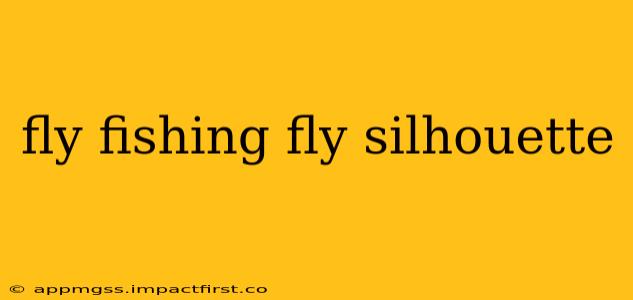Fly fishing is a nuanced sport, demanding both skill and an understanding of the intricacies of fly patterns. A crucial aspect, often overlooked, is the silhouette of the fly. Understanding how a fly appears to a fish – its silhouette – is key to successful fishing. This comprehensive guide delves into the importance of fly silhouettes, their design elements, and how to effectively use them to improve your catch rate.
What is a Fly Silhouette in Fly Fishing?
The fly silhouette is simply the outline or shape of the fly as seen by the fish from below the water's surface. It's the first thing a fish sees before it even registers the color or detail. A well-designed fly will mimic the silhouette of a natural insect or baitfish, triggering a predatory response. A poorly designed fly, on the other hand, may be ignored completely, no matter how realistic the details are from above the surface.
Why is Fly Silhouette Important for Fly Fishing Success?
The importance of silhouette in fly fishing can't be overstated. Fish primarily rely on sight to detect their prey. A fly's silhouette needs to be believable to entice a strike. Think of it this way: a perfectly painted fly with an unrealistic silhouette will fail to fool a discerning fish. Conversely, a simple fly with a realistic silhouette can be remarkably effective. This is why many successful fly patterns are minimalistic.
How Does Light Affect Fly Silhouettes?
Light penetration in water significantly impacts how a fly's silhouette is perceived. Shallow, clear water will offer a clearer view of the fly's details, while deeper, murkier water necessitates a strong, easily recognizable silhouette. This means that in clearer water, more detailed flies might be effective, whereas in murky water, a simpler, bolder silhouette is usually preferred. The angle of the sun also plays a role – at midday, the silhouette may be more pronounced, while during dawn or dusk, it may be softer.
What are the best materials for creating a strong fly silhouette?
The materials you choose directly influence the final silhouette of your fly. Materials that create a clear, defined outline work best. For example, dark-colored materials stand out against the water’s lighter background, creating a strong silhouette. Conversely, lighter-colored materials can create a less defined silhouette and might be less visible to fish. Materials like dark dubbing, dark-colored feathers, and even simple wire can help create a strong silhouette.
How to Design Flies with Effective Silhouettes?
Designing flies with effective silhouettes involves understanding the prey the fish is targeting. Observe the natural insects and baitfish in the area. Note their shapes and sizes. Consider the following:
- Simplicity: Often, a simple, well-proportioned silhouette is more effective than a highly detailed but unrealistic one.
- Size and Proportion: Ensure your fly's size and proportions are appropriate for the target fish and its usual prey. A fly that is too large or too small will likely be ignored.
- Contrast: Use dark and light materials strategically to create contrast and define the fly's shape against the water.
- Material Choice: Select materials that retain their shape and maintain a clear silhouette even when wet.
How can I improve my fly tying skills to create better silhouettes?
Improving your fly tying skills to create effective silhouettes requires practice and attention to detail. Start with simpler patterns and focus on creating clean, well-defined shapes. Pay close attention to the materials you use and how they interact with each other to form the overall silhouette. Experiment with different materials and techniques to find what works best in different conditions. Observe how your flies look underwater using polarized sunglasses – this is an invaluable tool for evaluating your fly’s silhouette in real-world conditions.
By understanding and mastering the art of the fly silhouette, you will significantly improve your fly fishing success. It's a critical element often overlooked, yet one that can dramatically improve your catch rate.
